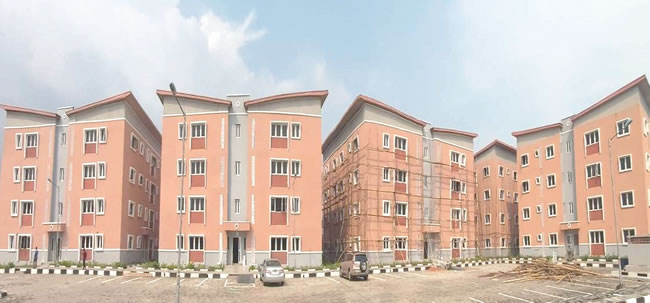New Opportunities For Affordable Housing Lenders
Citi Community Capital provided $160 million in construction financing and $117 million in permanent financing to DevCo, LLC, for Solera, a mixed-income project with 590 units of affordable and workforce housing in Renton, Washington.
Worries about the coronavirus pandemic fell away in 2021—at least for leading lenders of affordable housing properties.
“Construction shortages, rising labor costs, and rising materials costs—those are high on our list of worries,” says Kathy Millhouse, co-head of Citi Community Capital. But, affordable housing lenders like Citi no longer worry that COVID-19 will hurt the economics of their deals.
Lenders face many of the same challenges and opportunities in the pandemic recovery that they faced beforehand—only more so. The need for affordable housing has never been greater.
State and local housing officials are offering new housing programs, while a gridlocked Congress has not. Investors—from large national banks to Freddie Mac and Fannie Mae—are setting bold affordable housing goals. But escalating costs for materials, labor, and land make it harder for affordable housing lenders to put their capital to work. And as prices rise throughout the U.S. economy, Federal Reserve officials also are increasingly likely to raise interest rates.
All these factors make the race to lend to affordable housing properties faster and more challenging.
In 2021, Affordable Housing Finance’s Top 25 affordable housing lenders provided more than $63 billion in permanent and construction loans to developments that serve households earning up to 80% of the area median income (AMI). This is up from $51.8 billion in 2020 and $41 billion in 2019.
Top 25 Lenders of 2021
| Company | 2021 (in millions) | 2020 (in millions) |
|---|---|---|
| 1. Citi Community Capital | $5,639.6 | $7,002.4 |
| 2. KeyBank Real Estate Capital | $5,116.0 | $3,704.0 |
| 3. JPMorgan Chase | $4,843.0 | $2,671.0 |
| 4. Wells Fargo | $4,518.4 | $3,642.9 |
| 5. Bank of America | $4,026.8 | $3,532.4 |
| 6. JLL Real Estate Capital | $3,385.3 | $3,438.6 |
| 7. Berkadia | $3,285.0 | $1,144.0 |
| 8. Merchants Capital | $3,200.1 | $2,209.9 |
| 9. Lument | $3,181.0 | $3,048.8 |
| 10. Stifel, Nicolaus & Co. | $3,075.0 | $838.7 |
| 11. Greystone | $2,616.9 | $2,273.2 |
| 12. Deutsche Bank Securities | $1,946.0 | $1,339.8 |
| 13. M&T Bank | $1,812.6 | $1,299.1 |
| 14. CBRE | $1,779.6 | $2,242.0 |
| 15. Rockport Mortgage Corp. | $1,756.6 | $2,230.0 |
| 16. Capital One | $1,745.0 | $1,581.0 |
| 17. Truist Community Capital / Grandbridge Real Estate Capital | $1,628.5 | N/A |
| 18. Walker & Dunlop | $1,418.0 | $2,438.0 |
| 19. Red Stone Tax Exempt Funding | $1,372.5 | $817.6 |
| 20. PNC Real Estate | $1,297.3 | $1,452.9 |
| 21. U.S. Bank | $1,285.0 | $1,418.0 |
| 22. R4 Capital | $1,281.3 | $928.9 |
| 23. Bellwether Enterprise | $1,184.0 | $1,118.0 |
| 24. RBC Capital Markets | $898.5 | $978.0 |
| 25. Boston Capital Finance | $840.0 | $700.0 |
Note: The Top 25 rankings reflect only those companies that provided Affordable Housing Finance with figures. If you’d like to be considered for next year’s rankings, please contact Christine Serlin at cserlin@zondahome.com.
Citi Finds New Frontiers to Lend
The biggest affordable housing lender in 2021, Citi Community Capital, is looking for new places to make loans. This includes cities and towns where Citi does not have bank branches, so these loans won’t help it comply with the federal Community Reinvestment Act (CRA).
“We are trying to find areas of expansion,” says Barry Krinsky, national production manager for Citi. “There are places in the country where we are seeing more opportunity and some where there are less.”
Citi made $5.6 billion in affordable housing loans in 2021. However, that total is less than the $7 billion it lent in 2020 as well as less than the $6.1 billion it lent in 2019.
In recent years, Citi’s biggest deals provided tax-exempt loans to massive recapitalizations of existing affordable housing communities—such as redevelopments of public housing through the federal Rental Assistance Demonstration (RAD) program. These deals were often in the six gateway cities where Citibank has bank branches and needs to invest to meets its CRA obligations: Chicago, Los Angeles, New York City, San Francisco, South Florida including Miami, and Washington, D.C.
Those giant deals are harder and harder to find. California housing officials, for example, are increasingly focused on creating new affordable housing and not renovating older properties. “We are not seeing as much of the acquisition rehabs utilizing private-activity bond cap and 4% credits,” says Krinsky.
Citi is expanding into new markets where the demand of affordable housing is also strong, including places like Arizona, Oregon, and Washington state, even though Citi does not have a CRA need to lend in these places. Citi is also doing new business in Dallas, where Citibank has new bank branches, and the rest of Texas, where it does not.
Rapidly rising rents are making it easier for Citi to find deals.
“Rents have gotten to levels in places in Texas, for example, where they don’t need as much subsidy,” says Krinsky. “Therefore, more tax-exempt volume cap deals can get done.”
Lenders Have Growing ESG Motives
Leading lenders and new investors also have new motives to lend to affordable housing properties. That often includes their own tough environmental, social, and governance (ESG) standards for investing.
“Affordable housing is an important part of our efforts,” says Rob Likes, national manager of KeyBank Community Development Lending and Investment. “We continue to build on the success of our National Community Benefits Plan—a commitment to deliver more than $40 billion in affordable housing, mortgage and small business lending, and renewable energy.”
KeyBank lent $5.1 billion to affordable housing properties in 2021, up from $3.7 billion in 2020. That’s enough to make the bank the second biggest affordable housing lender of 2021.
More Affordable Housing Resources
Lawmakers and housing officials are creating programs to finance new affordable housing, and lenders like JPMorgan Chase are planning more loans as these programs come online.
“With the affordable housing crisis in the spotlight, we anticipate affordable housing resources to grow,” says Alice Carr, the former head of community development banking at JPMorgan Chase.
Chase also created a banking group to finance new development with help from resources other than housing tax credits. “We are working with non-housing institutions that have resources available for affordable housing,” says Carr. “That includes hospitals, tech companies, school districts, universities, and local municipalities.”
Chase lent $4.8 billion to affordable housing properties in 2021, up from $2.7 billion in 2020, making it the third biggest affordable housing lender of 2021.

Berkadia Plans Growth Despite Rising Interest Rates
Lenders like Berkadia expect to make even more loans to affordable housing properties in 2022 even though interest rates are expected to rise from their historic lows during the pandemic.
“We have all gotten used to low rates,” says Liz Diamond, managing director and head of affordable originations for Berkadia. “But we had been expecting them to rise for years now.”
Officials at the Federal Reserve plan to raise their benchmark interest rates several times in 2022 to slow down rising prices. Those higher rates are likely to ripple throughout the economy. The bond markets have already responded to the plan. The yield on 10-year U.S. Treasury bonds rose to about 2% in February. That’s up from roughly 1.5% in most of 2021, and it’s the highest the yield has been since before the pandemic.
“The Fed has gone out of their way to speak to their plans,” says Diamond. So far, that plan appears to be several modest rates hikes—perhaps three raises of 25 basis points each by the end of 2022—rather than a sudden, larger increase in interest rates. “Notwithstanding the Fed’s actions, if there is a sudden increase in rates, a jump of 100 basis points, we will see lot of deals that don’t work.”
Higher interest rates are likely to have an immediate effect on the size of the loans that are available. Investors pay high prices for all types of multifamily real estate, relative to the income from the property. The usual requirements that a loan be no larger than 80% of the value of a property are unlikely to matter. Freddie Mac and Fannie Mae loans are much more likely to be limited by their requirements that properties have enough income from rents to cover 1.2x the debt service. That requirement will force loans offered by lenders to shrink every time interest rates inch higher.
Berkadia is helping borrowers protect themselves by locking in low rates while they can. “We are having more of those conversations now,” says Diamond. Both Freddie Mac and Fannie Mae have a variety of rate-lock tools.
Berkadia lent $3.3 billion to affordable housing properties in 2021, including Freddie Mac, Fannie Mae, and the Department of Housing and Urban Development (HUD) loans. That’s roughly three times the $1.1 billion the firm lent in 2020—making Berkadia the seventh biggest affordable housing lender of 2021.
Strong Fundamentals Help Merchants Capital
Lenders also benefited in 2021 as the worst worries created by the pandemic eased. Affordable housing properties performed well during the pandemic, with dependable rents and few empty apartments. “Collections remained relatively strong,” says Dwayne George, executive vice president and national head of production for Merchants Capital.
Those strong fundamentals encouraged affordable housing developers to build. Low interest rates and relatively low construction costs also aided developers, which helped Merchants increase its lending to affordable housing properties by more than 50%.
Merchants Capital lent a total of $3.2 billion to affordable housing properties in 2021, up from $2.2 billion in 2020. That’s enough to make Merchants the eighth biggest affordable housing lender of 2021.
However, the cost of development has grown. By the first months of 2022, the cost of some materials had more than doubled. Construction workers are harder to find. “Rising interest rates are also cause for concern,” says George.
A labor shortage has also hurt affordable housing lending programs, he says. Many state agencies are short on staff and are taking longer to approve loans, says George.
HUD also lost staff who quit during the pandemic and due to budget cuts prior to the crisis. The few HUD staffers left are taking longer to approve the permanent Federal Housing Administration (FHA) loans many affordable developers rely on. “You had regional HUD queues of more than six months,” says George.
Fannie Mae and Freddie Mac also found an opportunity in the staff shortage to attract borrowers frustrated by FHA delays, says George. They offered these borrowers faster loan executions and lowered their usual interest rates 10 or 15 basis points to be more competitive with HUD, according to Merchants, which offers HUD as well as Fannie Mae and Freddie Mac loans.
Walker & Dunlop Lends to Workforce Housing
Freddie Mac and Fannie Mae have a strong motive to invest in affordable housing properties. The two mortgage giants now have to meet even tougher requirements set by officials at the Federal Housing Finance Agency (FHFA).
FHFA will allow Freddie Mac and Fannie Mae to purchase up to $78 billion each in loans to apartment properties in 2022. That’s up from $70 billion in 2021, even though the volume of financing borrowers want has increased much more quickly.
At least half of the multifamily loans bought by the government-sponsored enterprises must be to communities with rents affordable to low- and moderate-income households, and at least 25% of the loans must be to properties with rents affordable to households earning up to 60% of the area median income.
The new requirements have already made a difference.
In November, Walker & Dunlop closed a $124 million loan to The Avanti in District Heights, Maryland. The 930 apartments at the community first opened in 1965. They will stay relatively affordable thanks to an agreement between Fannie Mae and developers Dantes Community Partners, based in Washington, D.C., and Jonathan Rose Cos., based in New York City. That agreement doesn’t include government housing subsidies, other than a discount on the fixed interest rate of the Fannie Mae loan.
“That is something that you are going to see more and more,” says John Gilmore, managing director for Walker & Dunlop. The firm is also the largest lender in Fannie Mae’s Delegated Underwriting and Servicing program for multifamily properties.
Walker & Dunlop lent $1.4 billion to affordable housing properties in 2021, down from $2.4 billion in 2020. That was still enough to make Walker & Dunlop the 18th biggest affordable housing lender of 2021.




